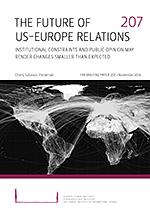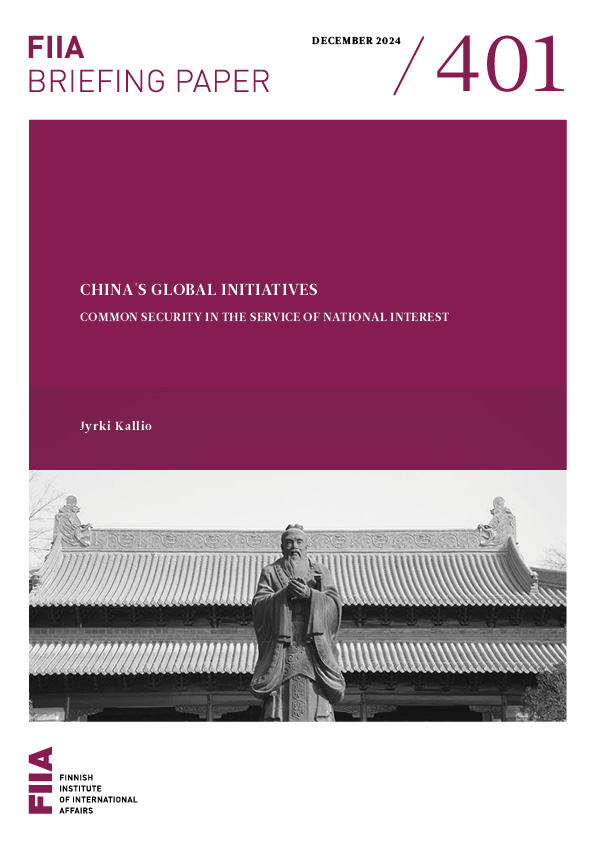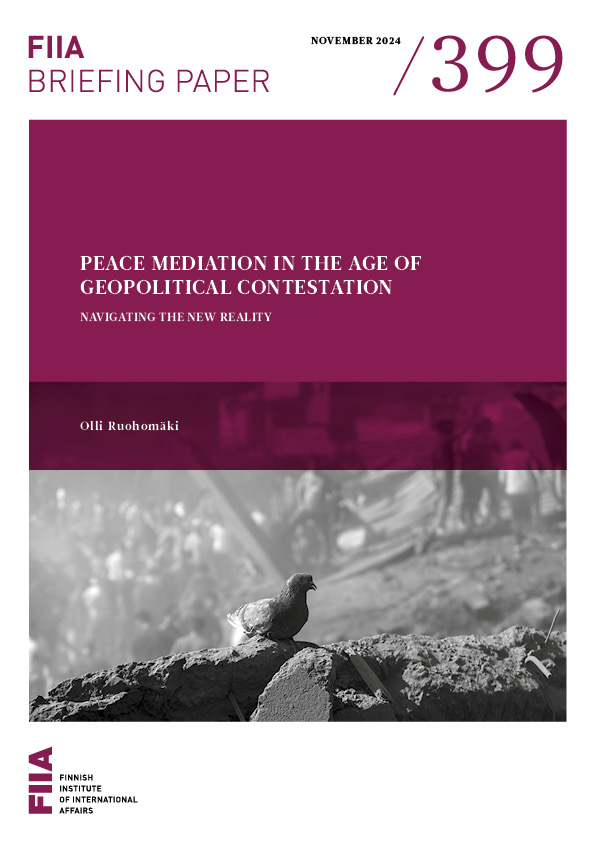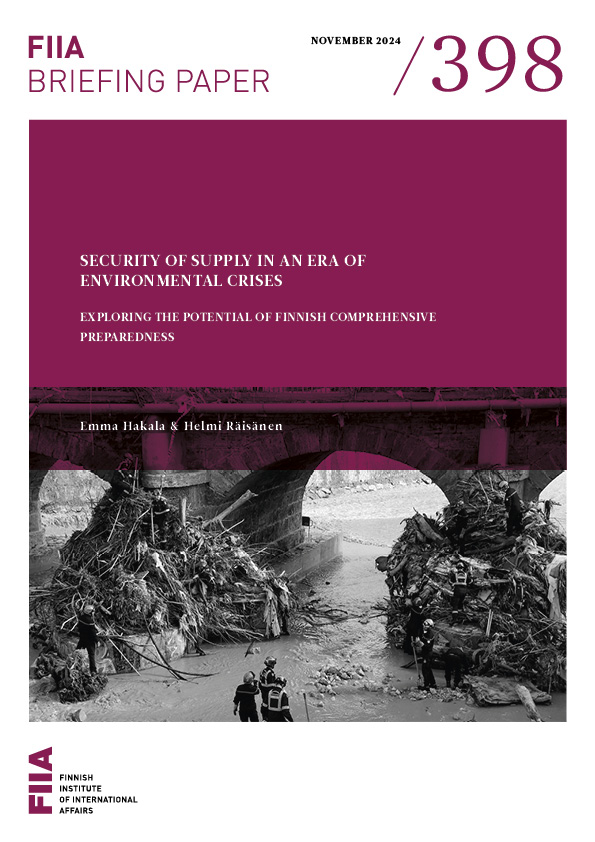The transatlantic relationship continues to evolve. However, even as US administrations change, the security and economic dimensions of the transatlantic relationship are not very susceptible to radical policy shifts, thanks to history, institutions and mutual interests.
Individual US presidents are, in theory, able to make sweeping changes to US participation and activity levels within NATO, for example, but in practice there are a number of constraints, which have led to the historical fact that US presidents have supported appropriate US security engagement in Europe and NATO.
While the US presidential election created the illusion that the next US president would seek to withdraw from agreements aimed at furthering trade liberalization, and that this would be supported by the population, actual opinion polls show strong support for continued US efforts to negotiate trade deals and actively engage in global trade.
The changing constancy of the transatlantic relationship
The prospect of considerably different approaches to the transatlantic relationship between the two American presidential candidates generated concern among European decision-makers. While nominally about the positions expressed by candidates Hillary Clinton and Donald Trump, the concerns were really a reflection of pre-existing anxieties about the status of the transatlantic relationship and for some, when it came to president-elect Trump, the broader debates about the future health of the global liberal world order.
Hillary Clinton was seen as someone who – vis-à-vis Europe – would have fundamentally continued within the spectrum of conventional post-WWII US foreign policy. Due to her long-standing experience with Europe, some saw her as likely to focus more intensely than President Obama on the transatlantic relationship and US interests in Europe. Donald Trump famously suggested that US alliance commitments in Europe were fundamentally transactional – if an ally fulfilled US expectations, assistance could be expected. Combined with a notably friendlier view of relations with Russia, this led many politicians and analysts to the conclusion that, if nothing else, a potential Trump presidency would be marked by considerably less predictability, and even reduced interest by the US in European affairs.
The transatlantic relationship will be different post-Obama, irrespective of who occupies the top posts in American foreign, security and economic policy. Yet the nature of the relationship, as well as the political realities, place certain constraints upon the extent to which an administration can, or is likely, to change course in the way relations between the United States and Europe writ large are handled. This briefing paper will explore the security and defence as well as trade-related factors that argue for the transatlantic relationship being quite consistent and stable, independent of who sits in the White House.
Presidential personalities matter, but organizations and mutual interests frame the transatlantic relationship
Individual presidents can certainly make significant policy choices that would impact the transatlantic relationship, such as refusing to continue funding European defence (through NATO) to the extent that the US does at present. Presidential personality also plays a role, with post-WWII US presidents showing varying levels of risk-averseness and differing variability and coherence in their decisions to use military force.1 The Cuban missile crisis and, more recently, the 2003 decision to invade Iraq are frequently presented as examples of this so-called ‘first image’ argumentation, whereby individual presidents and groups of individuals around them make more or less rational policy decisions that have significant impacts around the world.
However, both history and theories on the impact of organizational and bureaucratic processes on policy decisions, as well as the nature of the transatlantic relationship itself, suggest that the actual policy variance a US president would exhibit regarding matters that are central to the transatlantic relationship is relatively small. Historically, every US president has supported the American role in European security and NATO, while not infrequently complaining about the unequal financial burden it has placed on the United States and Europe. This support for NATO has largely been consistent, regardless of whether the dominant US foreign policy paradigm has been interventionist or less/non-interventionist.
While individuals matter, the standard patterns of behaviour of large organizations mean that any given policy issue is ‘coloured’ by the time it gets to the White House, and that ultimately even the president chooses from among a more limited set of policy options.2 This suggests that at the very least implementation is highly dependent on the relatively fixed bureaucracies at the departments of State and Defense. The White House, even if it concentrates foreign policy decision-making in the West Wing (as the Obama administrations did), is still only one of the actors that impact transatlantic policy and relations. Politically, Congress plays a role, as do – obviously – political and business leaders in Europe.
While the relationship consists of considerably more, it is cooperation vis-à-vis the two backbones –security and economic matters – that is the most frequently discussed aspect of the transatlantic relationship. What is notable is that even through the most rancorous recent periods of the relationship, such as the years surrounding the 2003 US decision to attack Iraq, the transatlantic relationship frayed but never came close to unravelling or being torn apart because of the highly institutional and interest-based ‘guideposts’ that frame the relationship in the long term. These stabilizing factors, and the public opinion that frequently supports them, are considered in greater detail below.
Transatlantic security: NATO’s refocus on collective defence re-energized transatlantic security cooperation
The security-related aspects of the transatlantic relationship frequently garner more publicity than the equally important economic and political/diplomatic components of the relationship. One of the reasons for this is that, in the security realm, the transatlantic relationship is formalized through the Washington Treaty and its institutional structure, in the form of the North Atlantic Treaty Organization (NATO). The practical, psychological and historical bonds created during American participation in both World Wars serve as a backdrop to this. This bond is reaffirmed on a daily basis on both sides of the Atlantic as thousands of military officers and other security officials from policy chiefs to tactical operators continue to cooperate.
Official orders from any given US administration influence the way in which this panoply of formal and informal relationships is used to advance policy, yet the very same bonds generate an elasticity which protects against the most egregious shocks that a demand or pronouncement by the US president or high-level officials could cause. This mechanism was readily apparent during the most difficult time for transatlantic security cooperation in recent decades, when disagreements over Iraq caused a serious rift in the public relationship, symbolized by the renaming of ‘French fries’ in the US Capitol as ‘Freedom fries’. Despite frequent public references to old and new Europe, security and intelligence cooperation continued during this period – the institutional frameworks were more influential than the politics of the day.
One concern voiced in Europe is that there is increasingly strong support for isolationism in the United States. Some even interpreted President-elect Trump’s ‘America First’ sentiments as supporting such a neo-isolationist policy. However, a closer reading of Trump’s comments and a look at public opinion polls does not support this assessment. Studies by both PEW Research and the Chicago Council on Foreign Affairs reveal strong support for the United States playing a leading role in global affairs.
For Europeans concerned that American politicians will focus their attention elsewhere, polls also suggest a strong historical, institutional and perhaps somewhat intuitive support for Europe. According to PEW, a majority of Americans have a favourable view of the European Union (53%) and the United Nations (64%). The variability of Europeans’ views on the United States is greater and clearly tied to perceptions about US presidents and the foreign policy they drive.
For example, in both France and Germany, around sixty per cent harboured a favourable view of the United States in 2002, this fell to between thirty-one and forty-five per cent between 2003 and 2008, only to rebound to between fifty-one and seventy-five per cent between 2009 and 2016.3 Interestingly, in the same survey, confidence in president-elect Trump “to do the right thing regarding world affairs” is tied to confidence in Russian President Vladimir Putin.4
Moreover, contrary to expectations based on frequently expressed concerns about a US ‘pivot to Asia’, 52% of Americans see ties with European nations as being most important, in contrast to 32% who see Asian countries as being paramount for the US. These are remarkably similar to the respective percentages seen in 1993, well before China had entered the public consciousness as a global trade giant, or the more recent ‘pivot to Asia’.5
Opinion polls on US Commitment to NATO vary but two reliable barometers, PEW and the Chicago Council on Global Affairs, show a continuing strong support, even among what is frequently argued to be the most isolationist group, core supporters of Donald Trump. American support for NATO also seems more stable compared with other member states surveyed by PEW Research during the past year, ranging from 53% having a favourable view of NATO in 2009 to 49% in 2015, and again 53% in 2016.6 This is slightly below the survey median of 57% that view NATO favourably. In the Netherlands, Poland, the UK, Italy, Germany, and Hungary, a majority of the population regard NATO favourably, while in France and Spain pluralities are favourably disposed towards the Alliance. Only in Greece is NATO viewed significantly more unfavourably than favourably.
Despite only a slim majority (53%) having a favourable opinion of NATO, more than three-quarters (77%) of Americans say that being a member of NATO is good for the United States. A perceived and real imbalance in sharing the costs of collective defence is one potential explanation for the apparent discrepancy in these numbers; Americans can see benefits but do not think NATO burden-sharing is fair at the moment. This sentiment has been frequently repeated by President-elect Trump. Different views on financing signal a potential challenge in the transatlantic relationship. Only in Poland and the Netherlands is there more support for increasing defence spending, while in other PEW-surveyed countries pluralities or majorities favoured maintaining the current levels of spending.
The Chicago Council on Global Affairs found that, overall, 12% of Americans wanted to increase and 14% decrease the country’s commitment to NATO, while 63% were satisfied with the current situation. Only 7% wanted to see the United States withdraw from the Alliance. This means that three-quarters of the population clearly support continued US engagement in and through NATO. Demographically, there is very little variation in support for NATO, and hence any changes to these views are likely to be driven by events, rather than by demographic changes.
The fact that over three-quarters of Americans think NATO is good for the US suggests that they intuitively grasp what is at the core of the US commitment to allies and alliances: self-interest. The global power and influence enjoyed by the United States is a function of its extensive network of alliances and partnerships. Maintaining this network by pledging to help defend its allies is useful first and foremost to the United States.
These sentiments are more broadly echoed in the Chicago Council on Global Affairs study, where 90% see that maintaining existing alliances is somewhat or very effective in achieving US foreign policy goals. Moreover, even 77% of core Trump supporters see building further new alliances as being a somewhat or very effective way of achieving foreign policy goals.7
Signing international agreements, frequently presented as limiting US room for manoeuvre in more conservative political circles in the United States, also receives clear majorities of support among Democrat, Republican, independent and core Trump voters, with 71% generally feeling that signing agreements is a somewhat or very effective way of furthering US foreign policy goals. Seven in ten also think that the United States should participate in the Paris Agreement to reduce greenhouse gas emissions, and in the International Criminal Court (ICC).8 The US populace is clearly considerably more multilateral and supportive of international engagement than is frequently feared in Europe and elsewhere in the world.
There is clearly strong support in the United States for both Europe and policy issues that Europeans frequently see as important. Combined with the fact that the United States and Europe need each other as they seek multilateral solutions to vexing global security-related challenges such as climate change, unequal economic development or terrorism, it seems clear that the web of transatlantic security relationships is dense enough to withstand individual problems, while also providing ‘guideposts’ that ensure most administrations’ policies towards Europe remain fairly predictable.
Smaller European states, even those located in strategically interesting locales – such as Finland – may even be shielded from the vagaries of presidential personality by the sheer fact that (good) relations are frequently maintained well below the White House threshold. This is in contrast to some larger countries such as Germany, France or the United Kingdom, which may be more dependent on the interpersonal relationships between the leaders of the respective countries.
Overall, the high levels of popular support, pragmatic arguments for it and extensive web of personal and institutional connections which, over the decades, have been woven into the tapestry of transatlantic security cooperation. This suggest that from the perspective of transatlantic security relations, the person who inhabits the White House is less relevant than sometimes imagined. This should provide solace for those most concerned about the prospect of unexpected changes in US policies towards Europe. It should also provide hope for those who, like most of the American populace, are convinced that American and European cooperation is necessary to sustain the broadly liberal world order that has come up against increasing challenges throughout the globe.
Transatlantic trade: Extensive and largely immune to the politics of the day
While security cooperation is more frequently the subject of public discussions regarding the state of the transatlantic relationship, the economic ties that bind the United States and Europe together turn the two into the ‘twin suns’ of the global trade system. This existing web of economic ties was to be further institutionalized through the Transatlantic Trade and Investment Partnership (TTIP), with some hoping and others fearing that the TTIP would serve as the foundation of an economic institutional relationship similar to that of the Washington Treaty in the security realm. At least in the near future, this now seems unlikely to come to fruition.
Although the tone of the US presidential campaign may have given the impression that most Americans would like to withdraw from free/liberal trade and agreements that have expanded it, the data do not support this. Around two-thirds of those polled in the Chicago Council on Global Affairs study agree with the statement that increasing connections between the US economy and others around the world is mostly good for the United States. Contrary to previous decades, it is now the Democrats who are more strongly in favour of, and have a more positive view towards trade than the Republicans.9
A clear majority of Americans even support the Transpacific Partnership (TPP), which has frequently been the focal point of ‘trade bashing’ during the past year’s election season. The explanations for this are legion, but one clear set of reasons has to do with how clearly large majorities think international trade benefits them as consumers (70%), and by improving their standard of living (64%).10
From a European and transatlantic perspective, such attitudes towards trade in general are welcomed. Together, the United States and the European Union account for approximately half of global GDP and, as per data compiled by the EU delegation to the US, see around four trillion USD of collective foreign direct investment in each other. With regard to investments, the relationship is diverse and robust. For example, between 2000 and 2014, US investments in the Netherlands were an order of magnitude greater than those in China. 11 In part, this is simply a function of path dependency, but is also related to the lack of genuine alternatives: both US and European companies appreciate the relatively predictable and stable social, economic and political environments they can operate in on both sides of the Atlantic.
As befits their status as the ‘twin suns’ of global trade, both are each other’s most important trade partner. In 2015, trade with the US accounted for 14.4% of EU imports and 20.7% of total EU exports. The trade relationship also continued to grow between 2011 and 2015, averaging an annual growth of 6.7% in imports and 8.9% in exports. Indicating a developed and relatively stable trade relationship in both imports and exports, industrial products dominate (95% of trade), with agriculture representing only around 5% in both exports and imports. Indicating the balance between trade in goods and services, the total US trade in goods and services with the EU totalled around $1.1 trillion in 2014, of which services accounted for an estimated $390 billion. In terms of goods trade, the EU exported $153 billion more than it imported in 2015. In services, the US trade surplus in 2014 was around $51 billion.12
In terms of trade, the US and EU relationship should continue to strengthen, and due to the broad and deep nature of transatlantic trade relations, any given US administration is limited in how it could dramatically impact it. However, disagreements over other country-specific approaches, such as whether or not to continue the opening up of trade with Iran due to the Iran nuclear deal could have political repercussions.
More broadly, cooperation between the US and the EU also has a global trade aspect. During the past half-century, both Europe and the United States have generally recognized that they need to continue cooperating to drive further global trade liberalization. The attempt to negotiate the TTIP was clear proof of this. A further ‘glue’ that should bind Europe and the United States closer together in trade negotiations and efforts to direct the nature of global trade is that they, to a far greater degree, share views about workers’ rights, environmental protection and so forth than is the case in Asian trade negotiations. This concern for workers’ rights – or at least a level playing field regarding them – is less likely to be challenged by a Trump administration, while it is likely that a Trump-led US would officially focus less on environmental protection.
Overall, trade agreements is one area where the individual personality and preferences of a US president do play a significant role, as the president can simply choose to focus on the kinds of multilateral or strictly bilateral trade deals he prefers.
Even strict regulatory challenges between the United States and EU are unlikely to genuinely impact the economic relationship as a whole. Certainly, decisions made in individual cases can set precedents, such as the EU Commission actions against US technology companies on antitrust, taxation or privacy matters, but the relationship as a whole will remain, as the tapestry of the transatlantic economic relationship is made up of thousands of individual corporate and human relationship strands, making the overall fabric of the relationship largely impervious to the politics of the day.
Security and trade (self-)interest continues to undergird transatlantic relations
While both the United States and Europe need to recalibrate expectations and accept a continually changing transatlantic relationship, both also face the responsibility or burden of continuing to cooperate for mutual self-interest, and more broadly to sustain the global liberal system. Both the United States and Europe continue to find security and trade benefits in continuing and deepening cooperation. This suggests that even if more strident ‘nationalist’ leaders emerge on both sides of the Atlantic, cooperation is likely to continue.
If cooperation does continue, it will positively impact two foundational pillars of the global liberal system: security cooperation, and extensive and expanding trade relations. It must be noted that expanding trade relations do not require the TTIP to come to fruition, yet laying the groundwork for being able to set global ‘trade-related’ standards would strengthen the two actors’ combined trading power.
In relation to security cooperation, since both political leaders and public opinion in the US see the unequal financial burden-sharing for European security as an important issue, Europe should by its own actions show that it understands its responsibilities in the security realm, and invest more coherently in its security as a whole. Certainly US interests in Europe will continue, but it would behove both sides to ensure that the relationship is viewed as positive by all parties.
As a whole, the transatlantic relationship is most appropriately understood as a tapestry composed of a myriad different threads, interwoven over centuries, with each generation adding new facets while being constrained by the work of their predecessors. Actions by new presidents and US administrations, and the continuing evolution of the European Union will certainly generate surprises, especially at national political and public levels. However, the strong popular support for US engagement in Europe and globally, and existing institutional constraints and ‘guideposts’, suggest that – barring an open military conflict between great powers in the region – the transatlantic relationship will continue largely as it has in the post-WWII era.
Endnotes
1 Gallagher, Maryann E. and Susan H. Allen (2014): “Presidential Personality: Not just a Nuisance.” Foreign Policy Analysis 10(1), pp. 1–21.
2 Allison, Graham T. (2005): ”Conceptual Models and the Cuban Missile Crisis”. In American Foreign Policy: Theoretical Essays 5th ed.
3 PEW Global Indicators Database: http://www.pewglobal.org/database/indicator/1/survey/all/. Last accessed 17 Nov 2016.
4 Pew Research Center: Obama’s International Image Remains Strong in Europe and Asia. http://www.pewglobal.org/2016/06/29/2-obamas-international-image-remains-strong-in-europe-and-asia/. Last accessed 17 Nov 2016.
5 Pew Research Center: NATO, U.S. allies, the EU and UN. http://www.people-press.org/2016/05/05/6-nato-u-s-allies-the-eu-and-un/. Last accessed 20 Oct 2016.
6 Pew Research Center: Views of NATO and its role are mixed in U.S., other member nations. http://www.pewresearch.org/fact-tank/2016/03/28/views-of-nato-and-its-role-are-mixed-in-u-s-other-member-nations/. Last accessed 20 Oct 2016. Pew Research Center: Support for NATO is widespread among member nations. http://www.pewresearch.org/fact-tank/2016/07/06/support-for-nato-is-widespread-among-member-nations/. Last accessed 20 Oct 2016.
7 The Chicago Council on Global Affairs: 2016 Chicago Council Survey. America in the Age of Uncertainty. American Public Opinion and US Foreign Policy. p. 28. https://digital.thechicagocouncil.org/2016-survey. Last accessed 20 Oct 2016.
8 Ibid., p. 31.
9 The Chicago Council on Global Affairs: 2016 Chicago Council Survey. America in the Age of Uncertainty. American Public Opinion and US Foreign Policy. https://digital.thechicagocouncil.org/2016-survey. Last accessed 20 Oct 2016.
10 Ibid.
11 Delegation of the European Union to the United States: http://www.euintheus.org/what-we-do/eu-us-facts-figures/ and http://www.euintheus.org//data/wordpress/htdocs/wp-content/uploads/2013/01/INFOGRAPHIC_Banner_Stand_UPDATE_march_2015.jpg. European Commission: http://trade.ec.europa.eu/doclib/docs/2006/september/tradoc_113465.pdf. Eurostat: http://ec.europa.eu/eurostat/statistics-explained/index.php/USA-EU_-_international_trade_and_investment_statistics. Last accessed 20 Oct 2016.
12 Office of the United States Trade Representative: https://ustr.gov/countries-regions/europe-middle-east/europe/european-union. Last accessed 17 Nov 2016.








